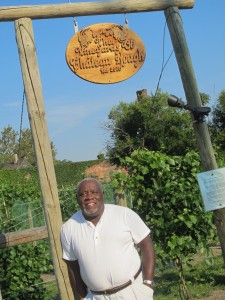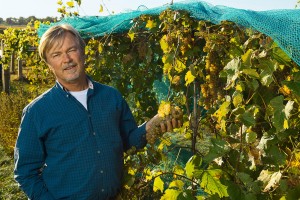Urban Vineyards Sprouting in the Midwest
Driving through Cleveland’s Hough neighborhood, the last thing you’d expect to come upon is a vineyard. Hough has long been one of Cleveland’s most distressed areas, site of the notorious ‘Hough riots” – the 1966 racial violence that still haunts these streets.
Yet, rising like a Phoenix from the ashes is Chateau Hough, almost an entire square block of beautiful, well-tended grapevines on the corner of East 66th Street and Hough Avenue. The vineyard is both a spectacle and a surprise: 294 vines total with seven rows each of hardy Traminette and Frontenac.
‘I was growing fruit trees and vegetables in my own garden,” says Mansfield Frazier, the enterprising writer who created Chateau Hough, gesturing toward his home across the street, ‘and neighbors joked that I should put in some vines.”
‘My goal was to create wealth with this land and upgrade the neighborhood,” Frazier says. “Grapes take more time than vegetables – we could raise bell peppers and sell them that same fall – but grapes bring the highest return.”
Frazier bought vines from upstate New York with a $15,000 grant from ReImagining Cleveland, a land re-use initiative. Neighbors pitched in to help turn over the earth, spread topsoil and plant his vines. Oriana House, a corrections agency, built the trellises and maintains the vineyard. A small, private foundation granted money for netting and other supplies. Cleveland Land Bank owns the land, so Frazier didn’t have to risk his own funds for the project.
Chateau Hough was planted in 2009, so the first harvest should have been this fall. However, Frazier says, ‘the birds got most of the grapes;” a minor setback in his view. Now that the vines are protected with nets, he’s planning a harvest party in 2013.
Frazier’s is the one of the few commercial vineyards located in an inner-city neighborhood. As reported in Midwest Wine Press during January, Gomer’s of Missouri, a wine and spirits store in Kansas City, won a Jefferson Cup for a wine made from grapes grown on the side of a store in a strip mall.
See related story: Gomer’s of Missouri Wins Jefferson Cup
Joe Henke of Henke Winery in Cincinnati also has about 50 vines outside his winery in Cincinnati, but his vines are ‘more for the ambience,” Henke says. Like Frazier, he too was unable to harvest his grapes because, ‘birds are too anxious in the city.”
Birds are just one of the challenges urban growers can expect, says northern Illinois viticulturist William H. Shoemaker. Recently retired from his position as a researcher at the University of Illinois, Shoemaker remains involved with the University’s research vineyard in St. Charles on the fringe of the Chicago megalopolis.
The first challenge, according to Shoemaker, is finding sufficient land in the city to grow grapes commercially. ‘Although it’s not unusual to find two or three suitable acres in an urban area,” he says.
No one has successfully started a vineyard in Chicago, but not for lack of trying. Before his death in March 2012, William Lavicka unsuccessfully fought the City of Chicago for approval to plant a small vineyard in a brownfield site on the South Side of Chicago.
As troublesome for successful urban grape growing is the wildlife one finds in cities – raccoons, birds, deer, rats and mice – that will feed on grape vines. ‘In rural areas, growers use noise devices to scare off birds and some animals, but you can’t do that in the city,” Shoemaker says. ‘Even bird netting brings issues; if a bird gets caught and dies, neighbors might get upset.”
Vacant lots in residential neighborhoods usually pose no environmental or health hazards, he adds, but industrial sites could be a problem. ‘The soil could be contaminated with heavy metals such as cadmium,” Shoemaker says. ‘In reclaiming that type of site for a vineyard, you would want to do an intensive soil analysis.”
His advice to would-be urban growers is to ‘do a lot of homework, talk to local wineries, see what kinds of grapes they’d want to buy and what grows well. And know your own environment and its challenges such as flooding and pests.”
In Michigan, the obstacles to an urban vineyard are political. Blake Kownacki, the winemaker for Michigan’s Cherry Creek and Sleeping Bear Wineries, wants to plant grapes on 10 acres of Belle Isle, the state-owned island park in Detroit. Some city and state officials and the Belle Isle Conservancy oppose his proposed Detroit City Cellars, while others would welcome it.
‘I see Detroit as prime vineyard territory,” Kownacki says, ‘with its proximity to lakes and rivers, the soil, and a mediating climate it’s the perfect backdrop for vines.” Kownacki wants to lease the Belle Isle land and, once his vineyard is established, start a program to turn urban gardens throughout Detroit into mini-vineyards. He envisions city residents tending their vines and selling the grapes back to Kownacki, thus creating side incomes for urban families.
Kownacki would love to plant vines next spring, but he says, ‘Right now it’s a waiting game. We’ve had all the meetings, knocked on all the doors. The best thing I can do is to keep making world-class wines and showing Michigan’s potential.”
Mansfield Frazier, meanwhile, has big plans for Chateau Hough. He’s already speaking with high-end restaurants about buying his wine. And in partnership with Kent State University, Frazier plans to turn an abandoned building on the property into a BioCellar site which is a type of ‘indoor farm” using solar energy.
Far-fetched? Possibly – but with Mansfield Frazier, transformation is nothing new. The son of a church deacon who ran an after-hours gambling joint, Frazier’s distant past includes prison time for counterfeit and fraud. ‘You should take control of your community,” Frazier says. ‘Rebirth is the theme here. Why not change Hough? Why not change any run-down neighborhood?”
When Frazier speaks, surrounded by tidy rows of grapevines at Chateau Hough, it all seems possible.
[wp_geo_map]





Great story and congratulations to Mr. Fazier for turning around his life and also the inner city plot of land he is tending. If more people do this type of activity, our Midwest cities could become very different with agrarian sections that feed the people healthy food and young people learning to love both the city and the land.